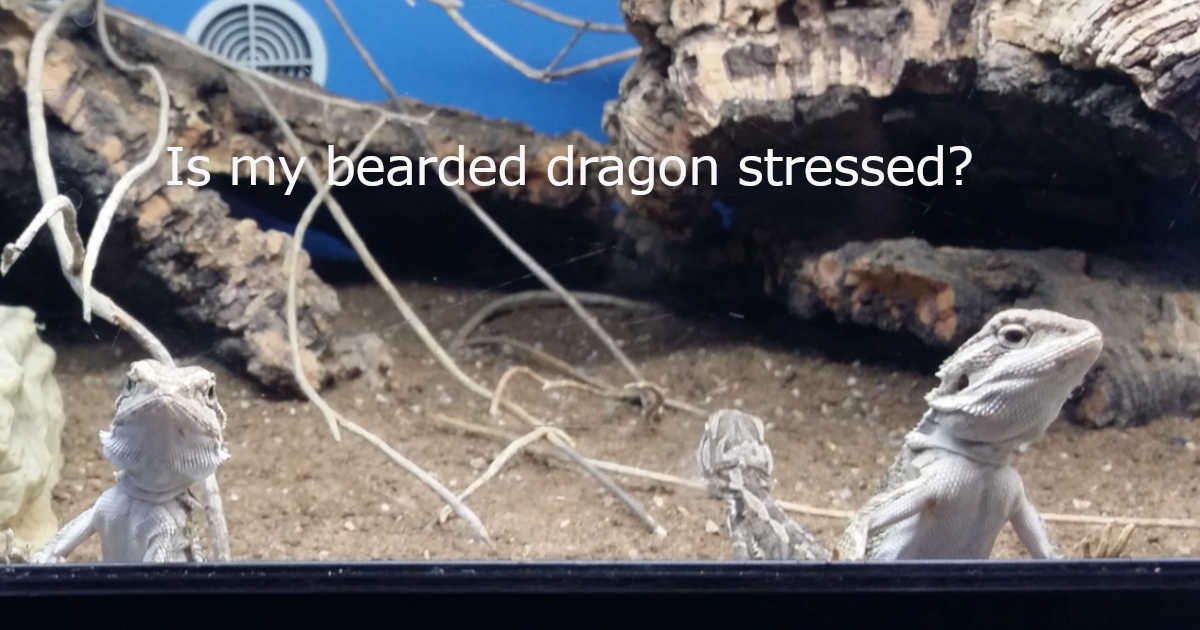Introduction to Stress in Bearded Dragons
Stress in bearded dragons is a significant aspect of their welfare. Despite being often perceived as less expressive compared to mammals or birds, reptiles like bearded dragons exhibit a range of behaviors that are crucial indicators of their welfare. They have complex physiological and psychological needs that must be adequately met.

Jump To…
Discerning Normal from Abnormal Behaviors
In the realm of reptilian behavior, understanding the natural tendencies and their appropriate range in various contexts is key. For example, it’s perfectly normal for reptiles in their wild habitat to engage in significant locomotor activity for hunting purposes. This is in stark contrast to captive environments where food is readily available, and reduced movement in a confined space can actually be harmful and indicative of abnormal behavior (Warwick, Arena, Lindley, Jessop & Steedman 2013).
In the wild, stress is a natural aspect of life, and animals are adapted to cope with specific challenges within an environment that broadly meets their needs. Contrastingly, in captivity, artificial substitutes often fail to fulfill essential biological requirements such as hunting, ample space for movement, and exploration of their habitat (Arena and Warwick 2004; Warwick 2004).
Bearded dragons are sentient beings capable of feeling the stresses captivity can create. This may lead to a range of behavioral issues, including an increase in abnormal behaviors, a decrease in behavioral diversity, heightened vigilance, tendencies to hide, increased fearfulness, startling easily, aggression, and a decrease in exploration and reproductive behaviors (Morgan and Tromborg, 2007).
Signs of Stress in Bearded Dragons
Understanding stress in bearded dragons involves recognizing it as a biological reaction to any factor that disrupts their normal state, impacting their physical systems. This can be observed and measured through various indicators.
- Behavioral Signs of Stress:
Signs of stress in bearded dragons may be seen in their behavior. Warwick, Arena, Lindley, Jessop, & Steedman (2013) conducted research on the behaviors reptiles exhibit that indicate stress or discomfort. These behaviors can be subtle and are often overlooked or misinterpreted. Common signs include:- Interaction with Transparent Boundaries: Reptiles may persistently try to push, crawl up, or dig under the transparent barriers of their enclosure, indicating a failure to recognize these boundaries and a desire for escape.
A bearded dragon glass surfing is where it repeatedly moves up against the glass walls of their enclosure. Glass surfing usually indicates stress in bearded dragons due to environmental factors, such as inadequate space, incorrect lighting and heating, or the presence of new tank mates.
Rostral lesions (rubbing the skin off their nose or face) may result from persistent interaction (touching or banging its head) with enclosure boundaries. - Hyperactivity and Hypoactivity: Both excessive and insufficient activity levels can be signs of stress. These might stem from environmental factors like overcrowding or temperature issues.
- Abnormal Feeding Behavior: Changes in eating habits, such as anorexia or overeating, can be indicators of stress or illness.
Obesity in bearded dragons is often due to overfeeding and low activity in captivity. Obesity can result in serious conditions like hepatic lipidosis (fatty liver disease). Fatty liver disease is especially common in bearded dragons (Barboza, Beaufrère, Reavill and Susta, 2022). - Aggression and Defensive Behavior: These behaviors, whether directed towards humans or other co-occupants, often stem from fear or a need to defend territory.
- Interaction with Transparent Boundaries: Reptiles may persistently try to push, crawl up, or dig under the transparent barriers of their enclosure, indicating a failure to recognize these boundaries and a desire for escape.
- Responses of the Autonomic Nervous System Alterations
During the initial stress response, the sympathetic nervous system of bearded dragons activates, influencing various bodily functions, including heart rate and glucose levels. Key responses include:- Cardiovascular Changes: Stress can lead to variations in heart rate and blood pressure due to the activation of the sympathetic nervous system.
- Metabolic Shifts: Stress can disrupt normal glucose regulation, affecting the dragon’s metabolism.
- Neuro-Endocrine Changes
Stress triggers hormonal shifts in the neuro-endocrine system, involving the hypothalamus, pituitary, and adrenal glands. These changes encompass:- Elevated Corticosteroid Levels: The adrenal glands produce more corticosteroids in response to stress, stimulated by the hypothalamus and pituitary gland.
- Hormonal Fluctuations: Other hormones that play a role in stress response may also experience changes.
- Immune Responses
Stress significantly influences the immune system of bearded dragons, governed by the hypothalamus and corticotrophin-releasing hormone:- Weakened Immunity: Prolonged stress can suppress the immune system, increasing susceptibility to infections and diseases.
- Hormonal Regulation: The hypothalamus and corticotrophin-releasing hormone are crucial in adjusting the immune response during stress.
What Makes a Bearded Dragon Stressed?
There are numerous factors that can make a bearded dragon stressed, including:
- Inadequate Habitat
- Lack of Natural Environmental Enrichment: Reptiles are often kept in captive environments that differ significantly from their natural habitats. While these environments are designed to be safe and controlled, they can inadvertently cause chronic stress in bearded dragons.
- Small and Inappropriate Enclosures: In the wild, bearded dragons have vast spaces to explore, but in captivity, they are often confined to relatively small enclosures. Tanks and other small cages are inappropriate, often as small as 4 foot long. This limitation can lead to stress and boredom. A restricted environment lacks the necessary stimuli that these animals would naturally encounter, leading to a range of stress-induced behaviors.
- Improper Lighting, Temperature and Humidity: Conditions such as improper lighting, UV setup, temperature, and humidity levels that don’t mimic their natural habitat can cause significant stress in bearded dragons. For instance, bearded dragons require specific temperature gradients for their metabolic processes, and failure to provide these conditions can lead to physiological stress.
- Sudden Changes to Habitat: Sudden changes in their environment, like rearranging their enclosure or moving to a new location, can cause stress.
- Stress from Handling
- Regular interaction with humans, including handling, can cause stress in bearded dragons. Studies suggest that even gentle handling may increase anxiety in these reptiles. While some bearded dragons might become accustomed to human interaction, others may find it a continual source of stress. Techniques for taming a bearded dragon may assist.
- Stress from Noise
- Research by Kepas, Sermersheim, Hudson, Lehmicke and Aubry (2023) on the Colorado checkered whiptail highlights that noise-induced stress in reptiles can lead to various physical and behavioral changes. These may include altered eating patterns, aggression, altered feeding patterns or attempts to escape. In the long term, continuous exposure to noise can lead to chronic stress, adversely affecting their immune system and overall health.
- Breeding Season: During breeding season, bearded dragons may exhibit stress behaviors due to hormonal changes.
- Illness or Injury: Health issues, whether visible injuries or internal problems, can be a significant source of stress.
- Inadequate Diet: A diet that is not nutritionally balanced, lacks variety, is in excess or insufficient can lead to stress in bearded dragons.
- Co-Habitation Stress: Bearded dragons are solitary creatures and may become stressed if housed with other dragons or pets.
Reducing Stress in Bearded Dragons Through Environment
Caring for bearded dragons in captivity requires attention to their natural needs and behaviors. To ensure their well-being, it’s essential to replicate their natural habitat as closely as possible. Here are some key steps you can take:
- Spacious and Comfortable Enclosures: Provide a large enclosure that offers ample space for movement. Include areas for climbing and hiding, which are crucial for their physical and mental stimulation.
- Environmental Enrichment: Enhance their living space with various objects and structures that encourage natural behaviors like exploring and climbing. This not only keeps them physically active but also mentally engaged. Creating an environment that mimics the natural habitat of bearded dragons is crucial in reducing stress. This includes temperature gradients, hiding places, and opportunities for natural behaviors.
- Optimal Temperature and Lighting: Bearded dragons thrive in specific temperature conditions. Ensure that their enclosure has a gradient of temperatures and adequate UV lighting, which is vital for their health.
- Gentle Handling: While interaction is important, it’s crucial to handle bearded dragons with care. Reduce the frequency and duration of handling, especially if they show signs of stress.
- Observation and Care: Regularly monitor their behavior for any signs of stress or discomfort. Being attentive to their needs and behaviors will help you create a nurturing environment for them.
Behavior Signs of a Happy Bearded Dragon
Warwick, Arena, Lindley, Jessop & Steedman (2013) outlined some normal behaviors that were likely indicators of a reptile in a comfortable state.
- Normal/Relaxed Alertness: The reptile is calm and curious, interacting with its environment. When a reptile shows a relaxed interest or awareness towards objects nearby or something novel, accompanied by gentle visual explorations, it’s a positive sign. It indicates that the reptile is comfortably engaging with its surroundings without stress.
- Calm Environmental Investigation: When reptiles calmly smell or taste objects or the air around them, it’s a way of them sampling the chemical makeup of their environment. This relaxed behavior is a part of their normal routine to understand and interact with their habitat.
- Subtle Bodily Adjustments in Exploration: Observing subtle changes in a reptile’s body posture and orientation, such as the leisurely stretching of limbs while basking or comfortably positioning themselves using enclosure furnishings, is a sign of normal behavior. It reflects their natural thermoregulatory behavior and a state of rest.
- Relaxed Movement and Exploration: Unhurried body movements and locomotion in reptiles are indicative of relaxed environmental exploration. This type of behavior is often seen when they are engaged in normal activities like environmental investigation or searching for food.
- Handling and Interaction: When a snake or lizard is held by a handler or interacts with an object and maintains a relaxed, albeit firm, grip, it suggests they are comfortable. This is a good sign, showing they are relaxed and at ease in their current state.
- Natural Drinking Habits: Unhurried drinking is a sign of relaxed and normal maintenance behavior in reptiles. It’s a simple yet important aspect of their daily routine, indicating that they are comfortably hydrated without any stress.
- Feeding Behaviors: When reptiles feed in an unremarkable and routine manner, it’s a positive indicator. Relaxed feeding habits are crucial for their well-being, reflecting normal maintenance behavior.
- Breathing Patterns: Observing unremarkable and regular breathing in reptiles is another sign of a relaxed state. It’s a basic yet vital indicator of their overall comfort and stress-free existence.
- Physical Quiescence: When reptiles show unremarkable relaxed activity, free from signs of apprehension or fear, it’s a strong indicator of their well-being. This physical quiescence is what every reptile caregiver aims for, as it signifies a state of comfort and normalcy.
Implications for Reptile Owners and Veterinarians
Elevated corticosterone levels from prolonged stress can weaken the immune system and cause reproductive issues. Reptiles’ immune responses are generally slower than mammals’ and are influenced by environmental factors like temperature. Poor living conditions can increase the risk of infection. (Benn, McLelland and Whittaker 2019)
For those caring for bearded dragons, understanding and observing their behavior is essential for assessing health and welfare. Regular monitoring and professional assessment are critical in managing stress in bearded dragons.
Concluding Stress In Bearded Dragons
Learning about what normal and abnormal behaviors in bearded dragons looks like empowers owners to recognize and address potential issues, enhancing their pets’ quality of life.
While captive environments can provide safety and control, they can also be sources of stress in bearded dragons. Recognizing and mitigating this stress is key to ensuring the well-being of these fascinating reptiles.
By understanding their needs and providing an environment that mimics their natural habitat as closely as possible, owners can significantly improve the quality of life of their bearded dragon pets.
References
- Martínez Silvestre, A. (2014). How to Assess Stress in Reptiles. Journal of Exotic Pet Medicine, 23(3), 240–243.
- Kepas, M. E., Sermersheim, L. O., Hudson, S. B., Lehmicke, A. J. J., French, S. S., & Aubry, L. M. (2023). Behavior, stress and metabolism of a parthenogenic lizard in response to flyover noise. Frontiers in Amphibian and Reptile Science, 1.
- Benn, A., McLelland, D., & Whittaker, A. (2019). A Review of Welfare Assessment Methods in Reptiles, and Preliminary Application of the Welfare Quality® Protocol to the Pygmy Blue-Tongue Skink, Tiliqua adelaidensis, Using Animal-Based Measures. Animals, 9(1), 27.7
- Warwick, C., Arena, P., Lindley, S., Jessop, M., & Steedman, C. (2013). Assessing reptile welfare using behavioural criteria. In Practice, 35(3), 123–131.
- Arena, P. C., Bashaw, M. J., Grant, R., Howell, T., Martínez-Silvestre, A., & Warwick, C. (2023). Miscellaneous Factors. In Health and Welfare of Captive Reptiles (pp. 583-617). Cham: Springer International Publishing.
- Warwick, C. (2023). Psychological and behavioural principles and problems. In Health and welfare of captive reptiles (pp. 239-285). Cham: Springer International Publishing.
- Kreger, M. D. (1993). Zoo-Academic Collaborations: Physiological and Psychological Needs of Reptiles and Amphibians. Herpetologica, 49(4), 509–512.
- Barboza, T., Beaufrère, H., Reavill, D., & Susta, L. (2022). Morphological features of hepatic lipid changes in bearded dragons (Pogona vitticeps), and a proposed grading system. Veterinary Pathology, 60(1), 123–132.
FAQs
Why is my bearded dragon glass surfing?
A bearded dragon glass surfing usually indicates stress due to environmental factors, such as inadequate space, incorrect lighting or heating setup or the presence of new tank mates.
How Do I Know If My Bearded Dragon Is Stressed?
Behavioral assessment is key to understanding the physical and psychological state of bearded dragons. Indicators of stress or discomfort may include:
Eating very little if at all or overeating.
Hiding outside of brumation or sleeping time.
Overactive or under active.
Banging into boundaries.
Hyperalert.
Aggression, hissing, inflating body.
Changes in their body color.
Burns or injuries.





